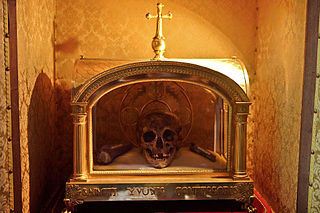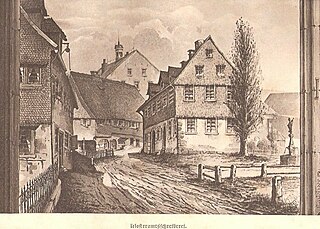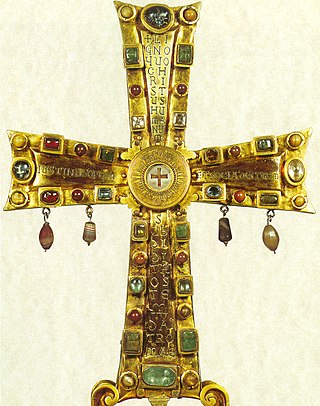
Ulrich crosses (German : Ulrichskreuze) are souvenir crosses originally given to pilgrims who visited the sepulchre of Saint Ulrich of Augsburg in the basilica that bears his name in Augsburg. [1]

Ulrich crosses (German : Ulrichskreuze) are souvenir crosses originally given to pilgrims who visited the sepulchre of Saint Ulrich of Augsburg in the basilica that bears his name in Augsburg. [1]

The Ulrich crosses represented the relic of the True Cross also kept in the basilica. [1] According to late medieval legend, Saint Ulrich was present at the Battle of the Lechfeld on 10 August 955. He was unarmed, carrying only a relic of the True Cross that had been given to him by an angel. In light of King Otto the Great's victory over the Hungarians, this relic became known as the Crux Victorialis ('cross of victory'). Historically, Ulrich was present, unarmed, with the defenders of Augsburg who went out to meet the invaders on 7 August. [2] It is unlikely he was present at the Lechfeld, however. [1]
Ulrich probably acquired his single piece of the True Cross on a trip to Rome. It is kept inside a reliquary created between 1280 and 1320. Originally designed to be worn in a pectoral cross, in 1494 it was placed within a cross-shaped Gothic case designed by goldsmith Georg Seld and his brother Nikolaus, commissioned by Abbot Johannes von Giltlingen. The story of Ulrich at the Lechfeld is depicted on the back of the case. [1] Although once attached to a chain and worn around the neck by the abbots of Saint Ulrich and Saint Afra, it is nowadays attached to a stand. [3]
The first souvenir crosses were made in the 17th century. They were produced by both stamping and casting. They came sometimes to be treated as talismans against mice and as such were buried in fields, cellars, etc. Most surviving examples come from Germany and Alsace–Lorraine, but some are found in museum collections further afield. [3] The dimensions of a typical cross are about 5.5 centimetres (2.2 in) square. [2] [4]

Joseph Friesenegger classifies the crosses into the following types: [5]
{{cite book}}: CS1 maint: location missing publisher (link)
Benedict of Nursia, often known as Saint Benedict, was an Italian Catholic monk. He is famed in the Catholic Church, the Eastern Orthodox Church, the Lutheran Churches, the Anglican Communion, and Old Catholic Churches. In 1964 Pope Paul VI declared Benedict a patron saint of Europe.

Ulrich of Augsburg, sometimes spelled Uodalric or Odalrici, was Prince-Bishop of Augsburg in the Holy Roman Empire. He was the first saint to be canonized not by a local authority but by the pope.

In religion, a relic is an object or article of religious significance from the past. It usually consists of the physical remains or personal effects of a saint or other person preserved for the purpose of veneration as a tangible memorial. Relics are an important aspect of some forms of Buddhism, Christianity, Islam, shamanism, and many other religions. Relic derives from the Latin reliquiae, meaning "remains", and a form of the Latin verb relinquere, to "leave behind, or abandon". A reliquary is a shrine that houses one or more religious relics.
Ulrich is a German given name derived from Old High German Uodalrich, Odalric. It is composed of the elements uodal- meaning "heritage" and -rih meaning "king, ruler". Attested from the 8th century as the name of Alamannic nobility, the name is popularly given from the high medieval period in reference to Saint Ulrich of Augsburg.

Maurus (512–584) was the first disciple of Benedict of Nursia. He is mentioned in Gregory the Great's biography of the latter as the first oblate, offered to the monastery by his noble Roman parents as a young boy to be brought up in the monastic life.

The tau cross is a T-shaped cross, sometimes with all three ends of the cross expanded. It is called a "tau cross" because it is shaped like the Greek letter tau, which in its upper-case form has the same appearance as the Latin letter T.

Saint Emmeram's Abbey was a Benedictine monastery founded around 739 at Regensburg in Bavaria at the grave of the itinerant Frankish bishop Saint Emmeram. The original abbey church is now a parish church named St. Emmeram's Basilica. The other buildings on the site form a large complex known as Schloss Thurn und Taxis or Schloss St. Emmeram, which has served as the main residence of the Thurn und Taxis princely family since the early 19th century.

Tegernsee Abbey is a former Benedictine monastery in the town and district of Tegernsee in Bavaria. Both the abbey and the town that grew up around it are named after the Tegernsee, the lake on the shores of which they are located. The name is from the Old High German tegarin seo, meaning great lake.

Diocese of Augsburg is a Latin diocese of the Catholic Church in Germany. The diocese is a suffragan of the Archdiocese of Munich.

A devotional medal is a medal issued for religious devotion.

St. George's Abbey in the Black Forest was a Benedictine monastery in St. Georgen im Schwarzwald in the southern Black Forest in Baden-Württemberg, Germany.

The Saint Benedict Medal is a Christian sacramental medal containing symbols and text related to the life of Saint Benedict of Nursia, used by Roman Catholics, Old Catholics, Lutherans, Western Orthodox, Anglicans and Methodists, in the Benedictine Christian tradition, especially votarists and oblates.

St. Ulrich's and St. Afra's Abbey, Augsburg is a former Benedictine abbey dedicated to Saint Ulrich and Saint Afra in the south of the old city in Augsburg, Bavaria.

Kreuzlingen Abbey, in Kreuzlingen in Switzerland, on the border with Germany, was founded in about 1125 by Ulrich I of Dillingen, Bishop of Constance, as a house of Augustinian Canons. In 1848, the government of the Canton of Thurgau dissolved the monastery and took over its property. The former abbey church of Saint Ulrich and Saint Afra, decorated in the Baroque style, is noteworthy.

Conrad of Constance was a German bishop and saint.

Augsburg-Haunstetten, also known as Haunstetten-Siebenbrunn is one of the seventeen Planungsräume of Augsburg, Bavaria, Germany. It is the largest of the seventeen Planungsräume with an area of 32.59 km² (12.58 mi²). It is one of the most heavily populated subdivisions of Augsburg, with over 25,000 inhabitants. The town of Siebenbrunn was its own entity until 1910 when it was annexed to Augsburg, and Haunstetten was its own city from 1952 until 1972, when Bavaria underwent extensive reform of its political subdivisions and Haunstetten was also annexed to Augsburg. The population stood at 26,291 as of December 31, 2010.

The Prince-Bishopric of Augsburg was one of the prince-bishoprics of the Holy Roman Empire, and belonged to the Swabian Circle. It should not be confused with the larger diocese of Augsburg, over which the prince-bishop exercised only spiritual authority.

The Cross of Justin II is a processional cross dating from the sixth century that is kept in the Treasury in St. Peter's Basilica, in Vatican City. It is also one of the oldest surviving claimed reliquaries of the True Cross, if not the oldest. It is a crux gemmata or jewelled cross, silver-gilt and adorned with jewels in gold settings, given to the people of Rome by the Emperor of the Eastern Roman (Byzantine) Empire, Justin II, who reigned from 565 to 578 in Constantinople, and his co-ruler and wife, the Empress Sophia.

The Cathedral of Augsburg is a Catholic cathedral in Augsburg, Bavaria, Germany, founded in the 11th century in Romanesque style, but with 14th-century Gothic additions. Together with the Basilica of St. Ulrich and Afra, it is one of the city's main attractions. It measures 113 x 40 m, and its towers are 62 m high. It is dedicated to the Visitation of Virgin Mary.

Nidker was the bishop of Augsburg from 816 until his death around 830.